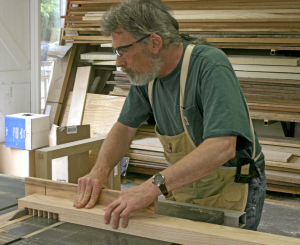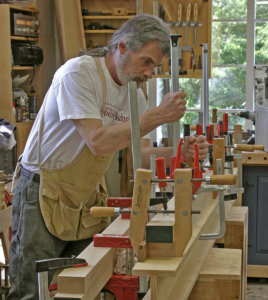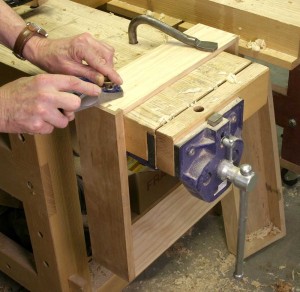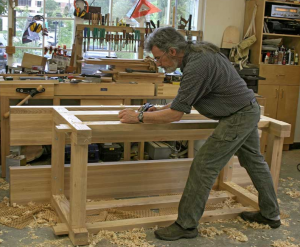We may receive a commission when you use our affiliate links. However, this does not impact our recommendations.
Bob Lang’s work over many years at Popular Woodworking Magazine is so rich and storied that it is hard to know where to start an article about the man. He is a renowned expert on both classic Arts & Crafts furniture and Google SketchUp modeling – expertise that shows his amazing range as a woodworker and designer, if you think about it. And Bob is just as agile when it comes to tools. He is a true hybrid woodworker – perhaps 60/40 in favor of power tools, but an amazing teacher of core hand-tool skills and the use of a blended shop.
So I decided to start this post where a woodworker starts any project – at the workbench. Bob’s bench is a modified Nicholson, dubbed the “21st-century Workbench,” and there are two huge advantages that I can see in this design. I give them to you in Bob’s own words here. Click on each point to visit the original blog sources and gain more insight on this practical, agile approach to the craft.
1. “I didn’t need a bench to build my bench. I made the top first, then placed that on a pair of horses.” (click here for the original article)
2. “A good workbench should be able to hold common furniture parts easily and securely so you can work on them. Drawers are pretty common and before I had this bench I cobbled together all sorts of devices and gizmos to hang onto a drawer to clean up the joints and plane down the sides. Now I just pull out one of the tool trays (you can see it leaning against the end of the bench in the photo at left) and slide the drawer box over the end of the bench. The drawer is at the same height as any other work, I can get at it from all sides, and most important, the corner is supported on the inside. I use a holdfast when cleaning up the joints – that lets me come in from any angle.” (click here for the original article)
Bob implies in one of his blog titles that there are at least 27 advantages to his workbench design. I have no doubt he is sincere. If you get that same sense, and want to start building in this mode, we have a great value right now with the “Bob Lang Collection.” The pack includes the full plans for the “21st-century Workbench,” along with many, many other projects. Buy it now and jumpstart your learning!
–Dan Farnbach
Here are some supplies and tools we find essential in our everyday work around the shop. We may receive a commission from sales referred by our links; however, we have carefully selected these products for their usefulness and quality.













Mr. Lang,
Thank you so much for taking the time to reply to my question about the dog holes. I just want to re-iterate how pleased I am with the design you came up with. So many of the workbench designs are geared for those who have large shops and big equipment. I was especially drawn to your design because it was geared around more typical home shop equipment, plus I think it is very practical and versatile. Thanks again, and keep up the great work!
I have recently just completed a version of the “21st Century Workbench”. I was very impressed with the thought that went into the design and functionality of this workbench. I consider myself just an average woodworker, and I learned many new skills and tricks building it. I would like to thank Robert Lang for a great design!
I do have a question for Mr. Lang, or anyone else who might know. This workbench has several dog holes along the front edge of the workbench. I assumed that they are to put a short dog into to support material along the front edge that is held in the front vise. Is that correct? How deep should these holes be?
Thanks.
I’m a big fan of Arts & Crafts furniture and I thought that Robert Lang’s: Classic Arts and Crafts Furniture, 14 timeless designs is as good a project book as I’ve seen anywhere as far as the A&C style is concerned.
Ah…the age of the worker is given away by the expressions he uses. How many woodworkers of the younger generation know what a gizmo is…and even better who he was?